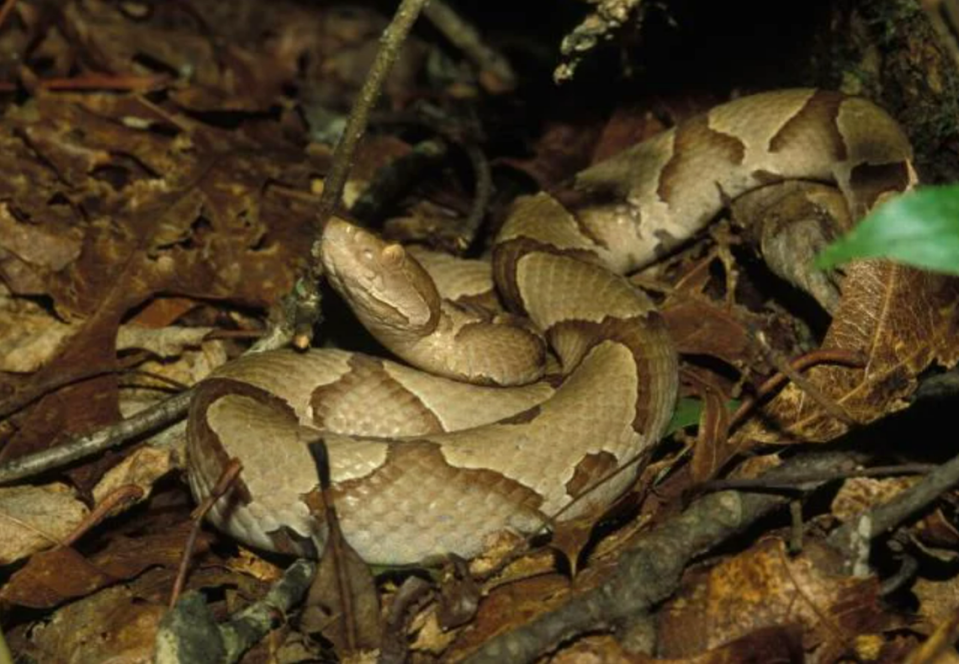How to identify a copperhead in Missouri and what to do if this venomous snake bites
Missouri is home to six types of venomous snakes — but only two are found in the Kansas City area. The more common of the two is the Eastern Copperhead, the most common venomous snake in Missouri. Its habitat also includes eastern Kansas.
Bites from venomous snakes are very rare in the Kansas City area, and usually occur when someone attempts to handle a venomous snake improperly. When treated with appropriate caution, Eastern Copperheads are docile and usually do not bite unless provoked.
In the rare event that you do get bitten by an Eastern Copperhead, there’s more good news: This snake’s venom is considered mild compared to that of other venomous snakes. But while a bite is unlikely to kill you, you should still know how to treat one — just in case.
You’re most likely to find this distinctive snake while hiking or exploring rocky, wooded and swampy areas. They’re also known to take refuge in abandoned rural buildings, creek banks and overgrown fields.
How can I identify an Eastern Copperhead?
This chubby snake is usually tan in color with distinctive hourglass-shaped brown splotches that are often edged in white. It is usually around 2 to 3 feet long, although it can reach lengths of over 4 feet when fully grown.
The Eastern Copperhead bears some signature characteristics that all the venomous snakes in Missouri share. Its pupils are vertical slits, and its head features heat sensing pits in front of the eyes that may look like an extra set of nostrils.
This snake also has a rattle on its tail that it will sound when alarmed — although you shouldn’t use this feature alone for identification. Some rattlesnakes may have missing or damaged rattles, while some non-venomous snakes may vibrate their tails to imitate a rattle, Missouri state herpetologist Jeff Briggler told The Star.
You can check out photos and videos of Eastern Copperheads on the Missouri Department of Conservation’s website.

How can I avoid being bitten by an Eastern Copperhead?
Briggler advised that adopting a “live and let live” approach with any snakes you encounter will reduce the risk of a bite.
“It’s best just to avoid them and let them move on their merry way,” he said. “Just like you have your path, your house and home, they have their path and places they go. So it’s just best to leave them alone and walk around them and move on.”
Eastern Copperheads are most commonly found in wooded, rocky and swampy areas with lots of groundcover and places to hide. That means you’re not likely to see one in a public park — although it is possible.
This snake is not particularly aggressive, and “will usually remain motionless when encountered,” according to the Missouri Department of Conservation.
“Look where you step, wear protective footwear, and don’t stick your hands under rocks or logs,” the department advises.
What should I do if an Eastern Copperhead bites me?
Dying from an Eastern Copperhead bite is practically unheard of — the Missouri Department of Conservation notes that these bites have a fatality rate of about 0.01%.
Nevertheless, it’s important to seek medical attention after any type of snake bite to ensure your wound is treated properly.
If you are bitten, Briggler and retired herpetologist Tom R. Johnson advise remaining calm, removing tight clothing and jewelry from the bitten area and seeking medical attention. They go over best practices in “A Guide to Missouri’s Snakes,” a free reference booklet published by the state’s department of conservation.
Even if you don’t think a snake is venomous, it’s best to seek medical attention for a bite to make sure. And if you can safely do so, Briggler recommended getting a photo of the snake that bit you or having a friend try to do so. A photo or detailed description can help first responders identify whether the snake was venomous.
However, using first aid measures you may have heard about in popular culture should be avoided.
“Applying a tourniquet, cutting and sucking out the venom, applying ice packs, electric shock therapy, or consuming alcohol or caffeinated drinks are not recommended for snakebites,” Briggler and Johnson wrote.
Do you have more questions about Missouri’s native wildlife? Ask the Service Journalism team at kcq@kcstar.com.

